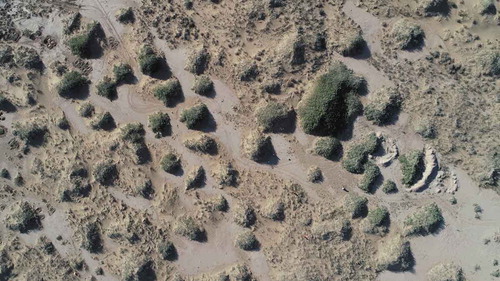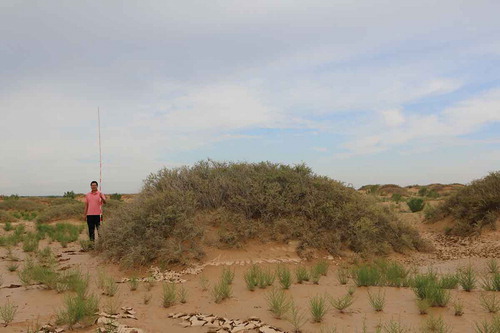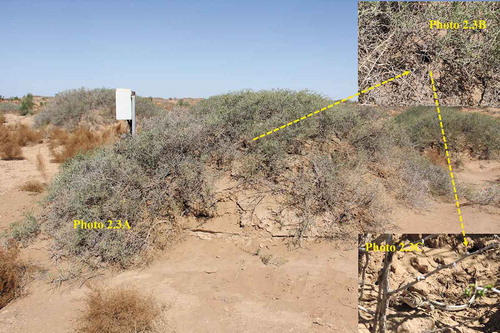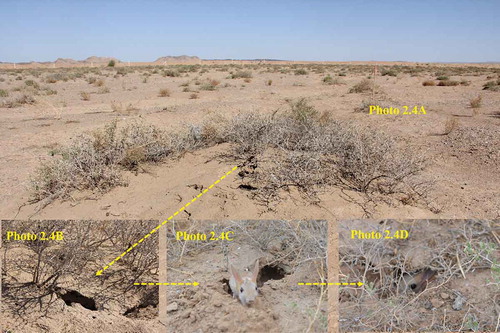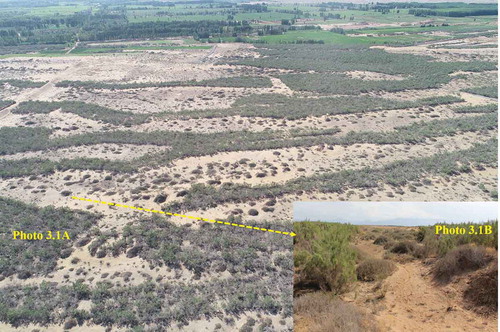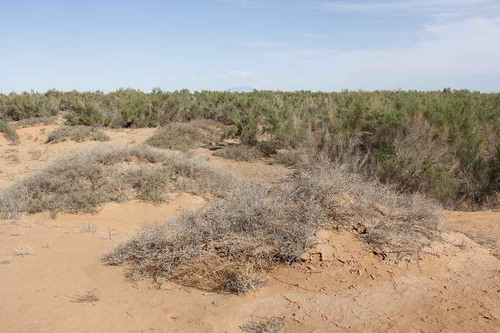ABSTRACT
Nebkhas are isolated mounds vegetated with burial-tolerant desert plants that trap windborne sediment within their canopies. Nebkhas are critical to desertification control and biodiversity protection of oases in arid and semi-arid regions of China, as they (ⅰ) trap windborne sediments and ensure oasis security; (ⅱ) as “fertile islands,” nebkhas can trap and provide a suitable micro-environment for seeds, birds, and small soil animals, and increase biodiversity; (ⅲ) increase the soil surface roughness and significantly reduce soil erosion following heavy rain. However, the establishment of sand-fixing vegetation and over-grazing significantly limits the development and accelerate the degradation of nebkhas, threatening oasis ecosystems. We provide background and recommendations for protective measures for nebkha landscapes in arid and semi-arid areas of China to aid managers in oasis protection.
Roles of nebkhas in desertification control and vegetation recovery
Nebkhas are isolated sediment mounds vegetated with burial-tolerant desert plants that trap windborne sediments within their canopies and form an important barrier for oasis ecosystems in arid and semi-arid regions of China. Nebkhas are critical in preventing desertification and in vegetation recovery of degraded lands (El-Bana, Nijs, and Khedr Citation2003; Quets et al. Citation2016; Luo and Zhao Citation2019). Because nebkhas can increase surface roughness and restrict sediment movement, they reduce mechanical damage to plant communities and prevent desert expansion (King, Nickling, and Gillies Citation2006; Okin, Gillette, and Herrick Citation2006) (, , ). It has been determined that most of the sediment which moves from the desert to oases can be trapped by nebkhas. Nebkhas can significantly reduce soil erosion following heavy rains, and increase runoff in inter-nebkha areas (Parsons et al. Citation2003; King, Nickling, and Gillies Citation2006) (, ).
Figure 1. Satellite image of Tamarix chinensis nebkhas landscape between an oasis and sand dunes (Photo 1.1A, Google map) and a close-up of a single T. chinensis nebkha (Photo 1.1B) in Qaidam Basin. Photo by Weicheng Luo
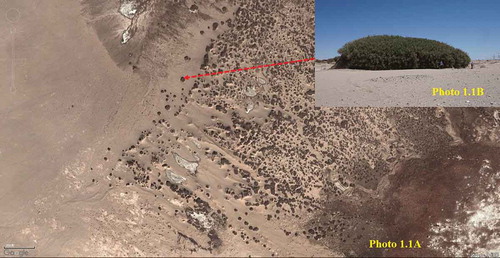
Figure 2. Tamarix chinensis nebkhas beside the oasis can trap windborne sediments transported from the desert. Photo by Weicheng Luo
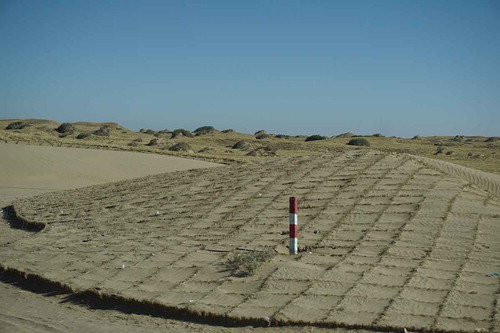
Figure 3. Nitraria tangutorum nebkhas landscape between an oasis and sand dunes of Mu Us Sandland. Photo by Weicheng Luo
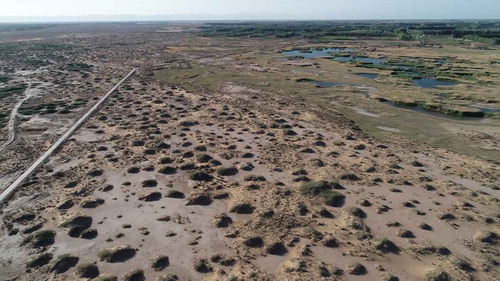
Nebkhas role in biodiversity protection
Nebkhas can encourage eolian sediment deposition, and retain water and nutrients into “fertile islands” (El-Bana, Nijs, and Kockelbergh Citation2002; Field et al. Citation2012). Large canopies of nebkhas shade direct sun radiation, prevent high soil temperatures, increase soil moisture content, and provide suitable habitats for birds and small soil animals (El-Bana, Nijs, and Khedr Citation2003). Further, nebkhas can provide a suitable micro-environment for seeds that are effectively trapped. Moreover, nebkhas leads to high vegetation cover of inter-nebkha areas (). In addition, the formation of nebkhas can increase biodiversity on its surface and prevent the loss of soil and other resources. In some harsh environments, nebkhas were an ideal habitat for birds and small soil animals (, , ).
Figure 6. Nitraria tangutorum nebkhas can effectively intercept seeds and lead to higher species richness in nebkhas than in inter-nebkha areas in Mu Us Sandland. Photo by Weicheng Luo
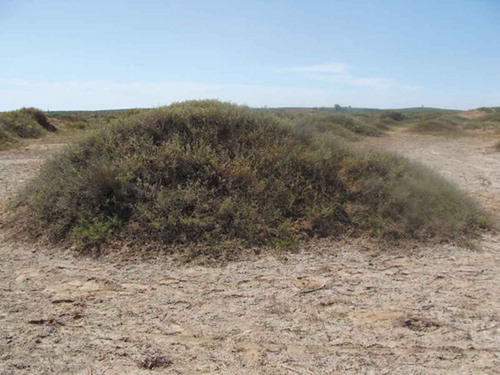
Figure 7. Nitraria tangutorum nebkhas are ideal habitats for Rhombomys opimus at the edge of Sandy Desert in the Hexi corridor. (Photo 2.2A, N. tangutorum nebkha; Photo 2.2B, R. opimus burrow; Photo 2.2 C, R. opimus prowls close to its burrow at night). Photo by Weicheng Luo

Influence of human activities on the development of nebkhas
Excessive human activities limit the development and accelerate the degradation of nebkhas. For example, the establishment of sand-fixing vegetation and engineering projects significantly limited sediment deposition of nebkhas and finally restricted nebkhas development (Qong, Takamura, and Hudaberdi Citation2002; Okin, Murray, and Schlesinger Citation2001; Luo and Zhao Citation2019) (0, ). Over-grazing and deforestation contribute to the reduction of vegetation cover on nebkhas, and acceleration of wind erosion effects on soil particles and plant litter, leading to degradation of nebkhas (Qong, Takamura, and Hudaberdi Citation2002; Okin, Murray, and Schlesinger Citation2001). After degradation, nebkhas have become new sand sources.
Conclusions
Desertification control and biodiversity protection are key for the sustainable development of oases in arid and semi-arid regions of China. Nebkhas play important roles in desertification control and biodiversity protection of oases. As an important barrier, nebkhas can trap windborne sediments transported from desert to oasis. In addition, as “fertile islands,” nebkhas provide suitable habitats for plants, birds, and small soil animals. However, some human activities, such as the establishment of sand-fixing vegetation and over-grazing, significantly accelerate the degradation of nebkhas. Protection of nebkhas, in particular of the host species, has played an important role in the stabilization of ecological environment in arid and semi-arid areas. Features of nebkha host species have a great influence on the shape characteristics, soil properties, balance between soil erosion and deposition, and on water recharge and consumption of nebkhas, and regional wind speed and sand sources; therefore, the key to the protection of nebkhas is prevention of host species destruction. Thus, we recommend the implementation of one of three protective measures for nebkha landscapes, including (1) establishment of a nature reserve to protect degraded nebkhas, (2) restriction of human activities such as overgrazing, and (3) limiting of sand-stabilizing vegetation.
Acknowledgments
We would like to thank Dr. Kathryn B. Piatek ([email protected]) for her assistance with English language editing and valuable comments on this article. We gratefully acknowledge the journal’s editors and anonymous reviewers for their valuable comments on our manuscript. This study was supported by the National Natural Science Foundation of China subsidization project (Grant No. 41701600) and National basic resource survey: Survey on the desert major plant communities in China [2017FY100200].
Disclosure statement
No potential conflict of interest was reported by the authors.
Additional information
Funding
References
- El-Bana, M. I., I. Nijs, and A. H. A. Khedr. 2003. “The Importance of Phytogenic Mounds (Nebkhas) for Restoration of Arid Degraded Rangelands in Northern Sinai.” Restoration Ecology 11: 317–7. doi:10.1046/j.1526-100X.2003.00222.x.
- El-Bana, M. I., I. Nijs, and F. Kockelbergh. 2002. “Microenvironmental and Vegetational Heterogeneity Induced by Phytogenic Nebkhas in an Arid Coastal Ecosystem.” Plant Soil 247: 283–293. doi:10.1023/A:1021548711206.
- Field, J. P., D. D. Breshears, J. J. Whicker, and C. B. Zou. 2012. “Sediment Capture by Vegetation Patches: Implications for Desertification and Increased Resource Redistribution.” J. Geophys. Research-Biogeosci 117: 1–9. doi:10.1029/2011JG001663.
- King, J., W. G. Nickling, and J. A. Gillies. 2006. “Aeolian Shear Stress Ratio Measurements within Mesquite-dominated Landscapes of the Chihuahuan Desert, New Mexico, USA.” Geomorphology 82: 229–244. doi:10.1016/j.geomorph.2006.05.004.
- Luo, W. C., and W. Z. Zhao. 2019. “Adventitious Roots are Key to the Development of Nebkhas in Extremely Arid Regions.” Plant and Soil 442: 471–482. doi:10.1007/s11104-019-04209-4.
- Okin, G. S., D. A. Gillette, and J. E. Herrick. 2006. “Multi-scale Controls on and Consequences of Aeolian Processes in Landscape Change in Arid and Semi-arid Environments.” Journal of Arid Environments 65: 253–275. doi:10.1016/j.jaridenv.2005.06.029.
- Okin, G. S., B. Murray, and W. H. Schlesinger. 2001. “Degradation of Sandy Arid Shrubland Environments: Observations, Process Modelling, and Management Implications.” Journal of Arid Environments 47: 123–144. doi:10.1006/jare.2000.0711.
- Parsons, A. J., J. Wainwright, W. H. Schlesinger, and A. D. Abrahams. 2003. “The Role of Overland Flow in Sediment and Nitrogen Budgets of Mesquite Dunefields, Southern New Mexico.” Journal of Arid Environments 53: 61–71. doi:10.1006/jare.2002.1021.
- Qong, M., H. Takamura, and M. Hudaberdi. 2002. “Formation and Internal Structure of Tamarix Cones in the Taklimakan Desert.” Journal of Arid Environments 50: 81–97.
- Quets, J. J., M. I. El-Bana, S. L. Al-Rowaily, A. M. Assaeed, S. Temmerman, and I. Nijs. 2016. “A Mechanism of Self-organization in A Desert with Phytogenic Mounds.” Ecosphere 7 (11). doi:10.1002/ecs2.1494.

